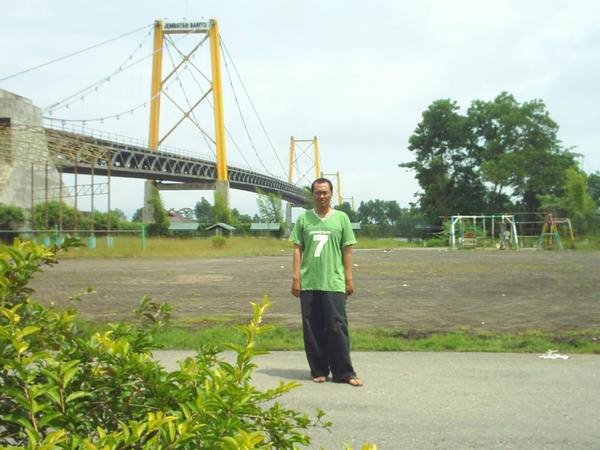perpus
tokobuah
allahuakbar
just put any comment on my blog
The learning style dimensions listed—Verbal/Visual, Intuitive/Sensory, Active/Reflective, Global/Sequential (Segmental)—come from the Felder-Silverman Learning Styles Model (FSLSM).
Richard M. Felder, a chemical engineering professor at North Carolina State University
Linda K. Silverman, an educational psychologist who contributed to the conceptual basis
1988, in their paper titled:
"Learning and Teaching Styles in Engineering Education" (Felder & Silverman, 1988)
The model was initially designed to improve engineering education but has since been widely applied in various educational contexts, including language learning and EFL settings.
It looks like you're listing different dimensions of learning styles. Here's a clearer breakdown and explanation of each pair to help organize your thoughts:
Verbal learners prefer written or spoken explanations. They learn best through words, reading, writing, and listening.
Visual learners prefer diagrams, charts, pictures, and other visual aids to understand and retain information.
Intuitive learners like to discover possibilities and relationships. They enjoy innovation, abstract thinking, and theoretical concepts.
Sensory learners prefer facts, data, and concrete information. They like practical applications and hands-on experiences.
Active learners retain information best by doing—discussing, applying, or explaining it to others.
Reflective learners prefer to think through the material quietly before acting. They learn by introspection and internal processing.
Global learners tend to learn in large jumps, absorbing material randomly before seeing the big picture. They often get sudden insights.
Sequential (Segmental) learners prefer linear steps and organized, logical progressions to understand material.
When you mention "learning style based on Silverman," you're most likely referring to Linda Silverman, an educational psychologist known for her work on visual-spatial and auditory-sequential learning styles. Her model is particularly influential in gifted education, though it applies more broadly to diverse learners.
Silverman proposed that learners typically fall along a continuum between two cognitive styles:
Think in images and pictures
Grasp the "big picture" but may struggle with details
Learn best through:
Diagrams, charts, videos
Hands-on activities
Mapping concepts
Often nonlinear thinkers and intuitive problem solvers
May find traditional teaching (step-by-step, auditory) challenging
Characteristics:
Strong imagination
Holistic thinking
Good at puzzles, spatial reasoning
May have difficulty expressing thoughts in words
Think in words and learn best through step-by-step instruction
Excel in traditional academic environments
Prefer:
Lectures, verbal instructions
Sequential tasks
Reading and writing
Are detail-oriented, analytical, and organized
Characteristics:
Linear thinkers
Good at remembering facts
Prefer routines and structure
Silverman emphasized the importance of adapting teaching methods to the learner's dominant style, rather than forcing all students to conform to a single approach. A mismatch between teaching and learning style can lead to underachievement or frustration, particularly for visual-spatial learners in auditory-sequential classrooms.
There are several kinds of learning styles that describe how individuals best absorb, process, and retain information. Here are the most commonly recognized types:
Learn best through images, diagrams, charts, and spatial understanding.
Prefer visual aids like mind maps, color-coded notes, and presentations.
Learn best through listening.
Prefer lectures, discussions, podcasts, and reading aloud.
Learn best through reading and writing.
Prefer written information such as textbooks, handouts, and taking notes.
Learn best through hands-on experience and movement.
Prefer doing, touching, building, role-playing, or using physical objects.
Learn best through reasoning, logic, and systems.
Prefer problem-solving, sequencing, and working with numbers or patterns.
Learn best through interaction with others.
Prefer group work, discussions, and collaborative activities.
Learn best alone.
Prefer self-study, reflection, and working independently.
Some frameworks (like VARK) focus more on the first four:
Visual
Aural
Read/Write
Kinesthetic
The first university in the world is widely considered to be the University of al-Qarawiyyin (also spelled Al-Karaouine), located in Fez, Morocco. It was founded in 859 CE by Fatima al-Fihri, a woman scholar and philanthropist.
Al-Qarawiyyin is recognized by UNESCO and the Guinness World Records as the oldest existing and continually operating degree-granting university in the world.
However, there are other contenders depending on how "university" is defined:
Nalanda University (India), established around the 5th century CE, was a major center of learning in ancient times, especially for Buddhist studies.
University of Bologna (Italy), founded in 1088, is often considered the oldest university in Europe and the first to use the term universitas for a community of teachers and scholars.
Today, the University of al-Qarawiyyin in Fez, Morocco, continues to function as both a religious and academic institution with a deep historical legacy. Here's a snapshot of its current status:
It primarily focuses on Islamic studies, including:
Islamic law (fiqh)
Theology
Classical Arabic grammar and linguistics
Hadith and Qur'anic studies
It also offers modern subjects such as mathematics, foreign languages, and astronomy in some programs.
Degrees from al-Qarawiyyin are recognized by Moroccan educational authorities.
The university is closely linked with the al-Qarawiyyin Mosque, which remains one of the most important places of worship and scholarship in the Islamic world.
It is a major center for Maliki jurisprudence (the dominant school of Sunni Islam in North and West Africa).
The library at al-Qarawiyyin, recently restored, is one of the oldest in the world and houses ancient manuscripts dating back over a thousand years.
The institution and its mosque are considered treasures of Islamic architecture and are protected heritage sites.
It attracts scholars and students from around the Islamic world, especially from West Africa, the Middle East, and other parts of North Africa.
It continues to be a symbol of female empowerment due to its founding by Fatima al-Fihri.
The first library in the world is generally considered to be the Library of Ashurbanipal, located in Nineveh (modern-day Iraq). It was established in the 7th century BCE by King Ashurbanipal of the Neo-Assyrian Empire.
Key facts about the Library of Ashurbanipal: Date: 7th century BCE (around 668–627 BCE).
Contents: Over 30,000 clay tablets written in cuneiform, including literature, religious texts, medical treatises, legal documents, and administrative records.
Languages: Mostly Akkadian and Sumerian.
Famous work: It contained the Epic of Gilgamesh, one of the oldest known literary works.
While earlier collections of texts existed (like temple archives in Sumer around 2600 BCE), the Library of Ashurbanipal is notable for being the first systematically organized library with a clear purpose of knowledge preservation.
The terms "UK" (United Kingdom) and "Great Britain" are often used interchangeably, but they actually refer to different things:
Full name: The United Kingdom of Great Britain and Northern Ireland
Includes:
England
Scotland
Wales
Northern Ireland
✅ This is the political entity — a country made up of four nations.
Refers to the island that includes:
England
Scotland
Wales
🚫 Does NOT include Northern Ireland
It's a geographical term, not a political one.
| Term | Includes | Type |
|---|---|---|
| UK | England, Scotland, Wales, N. Ireland | Political |
| Great Britain | England, Scotland, Wales | Geographical |
The competencies of elementary school teachers in the current era—often referred to as the "21st century" or the "digital era"—have expanded beyond traditional teaching skills. Today’s educators are expected to be adaptable, tech-savvy, and focused on holistic student development. Here’s a breakdown of key competencies for elementary school teachers in this era:
Mastery of subject matter and age-appropriate pedagogy
Ability to apply differentiated instruction to meet diverse learners' needs
Use of student-centered approaches (e.g., inquiry-based learning, project-based learning)
Integration of digital tools in teaching and assessment (e.g., using Google Classroom, interactive apps)
Basic troubleshooting and adaptation to new educational technologies
Promoting digital literacy among students
Clear, age-appropriate communication with students
Positive interaction with parents and school community
Collaboration with colleagues for interdisciplinary learning
Modeling good character and instilling values (honesty, responsibility, empathy)
Upholding ethical standards in teaching and student evaluation
Promoting inclusive and respectful classroom culture
Ability to analyze situations and make informed decisions
Encouraging students to think critically and ask questions
Reflecting on teaching practices for continuous improvement
Designing engaging and imaginative learning experiences
Encouraging students’ creativity and curiosity
Flexibility in adapting teaching methods
Commitment to continuous professional development
Staying updated with educational trends, curriculum changes, and pedagogy
Open to feedback and willing to learn from peers and experiences
Sensitivity to students’ diverse cultural backgrounds
Promoting global citizenship and cross-cultural understanding
Incorporating local and global issues in teaching
1. Pengantar Kewirausahaan
Kewirausahaan adalah konsep yang merujuk pada kemampuan seseorang untuk menciptakan, mengembangkan, dan menjalankan suatu usaha atau bisnis dengan tujuan menghasilkan keuntungan. Seorang wirausahawan adalah individu yang berani mengambil risiko dalam mengeksplorasi peluang bisnis baru dan menciptakan nilai ekonomi maupun sosial bagi masyarakat.
2. Asal Kata Kewirausahaan
Istilah kewirausahaan berasal dari kata dasar "wira" yang berarti pejuang, pahlawan, atau orang yang memiliki keberanian, dan "usaha" yang berarti kegiatan untuk mencapai tujuan tertentu. Maka, kewirausahaan mencerminkan semangat keberanian dalam menjalankan usaha atau bisnis secara mandiri.
3. Kewirausahaan sebagai Proses Kreatif dan Inovatif
Kewirausahaan bukan hanya soal membuka bisnis, tetapi juga melibatkan proses kreatif dan inovatif dalam menciptakan produk atau layanan baru. Wirausahawan dituntut untuk berpikir di luar kebiasaan, menciptakan solusi atas masalah yang ada, serta melihat peluang di tengah tantangan.
4. Ciri-ciri Kewirausahaan
Ciri khas dari kewirausahaan antara lain adalah berani mengambil risiko, memiliki visi jangka panjang, berpikir mandiri, memiliki jiwa kepemimpinan, serta gigih dalam menghadapi tantangan. Wirausahawan sukses biasanya juga mampu memotivasi tim dan menjalin kerja sama dengan berbagai pihak.
5. Tujuan Kewirausahaan
Tujuan utama dari kewirausahaan adalah menciptakan lapangan kerja baru, meningkatkan kesejahteraan ekonomi individu dan masyarakat, serta mendorong pertumbuhan ekonomi nasional. Kewirausahaan juga berkontribusi dalam menumbuhkan semangat inovasi dan persaingan sehat dalam dunia usaha.
6. Peran Kewirausahaan dalam Ekonomi
Kewirausahaan memainkan peran penting dalam perekonomian, karena menciptakan usaha kecil dan menengah yang menyerap tenaga kerja dalam jumlah besar. Selain itu, para wirausahawan juga mendorong terbentuknya pasar yang dinamis dan memperluas jaringan ekonomi lokal hingga global.
7. Jenis-jenis Kewirausahaan
Kewirausahaan dapat dibedakan menjadi beberapa jenis, seperti kewirausahaan bisnis, sosial, teknologi, dan digital. Kewirausahaan sosial, misalnya, berfokus pada penyelesaian masalah sosial dengan pendekatan bisnis, sementara kewirausahaan digital memanfaatkan teknologi untuk menciptakan solusi digital seperti aplikasi atau platform online.
8. Proses Menjadi Wirausahawan
Menjadi seorang wirausahawan bukanlah hal yang instan. Dibutuhkan proses belajar yang panjang, termasuk mempelajari pasar, menyusun rencana bisnis, mengelola keuangan, dan membangun jaringan. Banyak wirausahawan sukses yang memulai dari kegagalan, lalu bangkit dengan semangat yang lebih kuat.
9. Pendidikan dan Kewirausahaan
Pendidikan kewirausahaan sangat penting untuk ditanamkan sejak dini, karena dapat melatih kreativitas, keberanian mengambil keputusan, serta pola pikir inovatif. Saat ini banyak institusi pendidikan yang sudah memasukkan kewirausahaan ke dalam kurikulum, baik di tingkat sekolah maupun perguruan tinggi.
10. Tantangan dalam Kewirausahaan
Kewirausahaan tidak lepas dari tantangan, seperti persaingan pasar, keterbatasan modal, perubahan tren konsumen, hingga faktor regulasi pemerintah. Oleh karena itu, wirausahawan perlu memiliki kemampuan adaptasi dan manajemen risiko yang baik agar dapat bertahan dan berkembang.
11. Etika dalam Kewirausahaan
Etika juga merupakan bagian penting dalam kewirausahaan. Seorang wirausahawan harus menjunjung tinggi integritas, kejujuran, dan tanggung jawab sosial. Usaha yang dibangun dengan landasan etika yang kuat akan lebih berkelanjutan dan mendapat kepercayaan dari masyarakat.
12. Peran Teknologi dalam Kewirausahaan Modern
Perkembangan teknologi telah membuka peluang baru dalam dunia kewirausahaan. Saat ini, banyak usaha rintisan (startup) yang mengandalkan teknologi digital sebagai tulang punggung bisnisnya. Internet, media sosial, dan e-commerce memungkinkan para wirausahawan untuk menjangkau pasar lebih luas dengan biaya lebih efisien.
13. Kesimpulan
Kewirausahaan adalah kunci dalam membangun bangsa yang mandiri, kreatif, dan kompetitif. Dengan menumbuhkan semangat kewirausahaan, masyarakat tidak hanya bergantung pada lapangan kerja yang tersedia, tetapi juga mampu menciptakan peluang kerja baru. Oleh karena itu, pengembangan kewirausahaan harus menjadi perhatian bersama, baik oleh pemerintah, lembaga pendidikan, maupun masyarakat luas.
Perspektif global adalah cara pandang yang luas dan menyeluruh terhadap dunia, di mana individu atau kelompok melihat berbagai isu dan fenomena tidak hanya dari sudut pandang lokal atau nasional, tetapi juga dari skala internasional dan global. Perspektif ini menekankan pentingnya memahami keterhubungan antarnegara, antarmasyarakat, dan antarbudaya dalam dunia yang semakin terintegrasi.
Dalam era globalisasi, batas-batas geografis dan budaya semakin kabur. Informasi, teknologi, ekonomi, dan bahkan masalah sosial menyebar dengan cepat ke seluruh dunia. Oleh karena itu, kemampuan untuk melihat dan memahami isu-isu dalam konteks global menjadi sangat penting. Perspektif global memungkinkan seseorang untuk tidak hanya melihat akibat langsung, tetapi juga dampak tidak langsung dari suatu peristiwa di belahan dunia lain.
Pendidikan berperan penting dalam membentuk perspektif global. Siswa yang dibekali dengan pemahaman global akan lebih mampu memahami isu-isu seperti perubahan iklim, konflik internasional, ketimpangan ekonomi, dan migrasi. Mereka juga akan lebih terbuka terhadap perbedaan budaya dan lebih siap untuk menjadi warga dunia yang bertanggung jawab.
Salah satu aspek utama dari perspektif global adalah kesadaran akan keterkaitan (interdependensi) antara negara dan masyarakat. Misalnya, krisis ekonomi di satu negara bisa berdampak pada perekonomian global. Atau, polusi udara dari satu wilayah dapat memengaruhi kualitas udara di wilayah lain. Dengan perspektif ini, kita belajar bahwa tindakan lokal sering kali memiliki konsekuensi global.
Perspektif global juga menekankan pentingnya empati lintas budaya. Dengan memahami budaya, nilai, dan cara hidup masyarakat lain, kita bisa membangun toleransi dan menghargai keberagaman. Ini sangat penting dalam dunia multikultural yang rentan terhadap prasangka, stereotip, dan konflik antarbudaya.
Dalam konteks ekonomi, perspektif global membantu individu memahami bagaimana sistem perdagangan internasional, pasar tenaga kerja global, dan produksi lintas negara bekerja. Konsumen yang sadar global akan mempertimbangkan dari mana barang yang mereka beli berasal, bagaimana barang tersebut diproduksi, dan apakah proses produksinya etis.
Dari segi lingkungan, perspektif global sangat penting dalam menghadapi tantangan seperti perubahan iklim, deforestasi, dan pencemaran laut. Isu-isu ini tidak mengenal batas negara dan hanya bisa ditangani melalui kerja sama internasional. Oleh karena itu, warga dunia perlu memiliki kesadaran global tentang pentingnya menjaga planet ini bersama-sama.
Dalam dunia kerja, perspektif global semakin dibutuhkan. Perusahaan multinasional mencari tenaga kerja yang memiliki kemampuan berpikir global, mampu bekerja dalam tim lintas budaya, dan memahami dinamika pasar internasional. Ini menuntut kemampuan komunikasi, adaptasi, dan kolaborasi di lingkungan yang beragam.
Media sosial dan teknologi informasi juga berperan dalam membentuk perspektif global. Dengan akses internet, seseorang bisa mendapatkan informasi dari berbagai belahan dunia dalam hitungan detik. Namun, ini juga menuntut literasi digital dan kemampuan berpikir kritis agar tidak terjebak dalam disinformasi atau bias lokal.
Dalam bidang politik, perspektif global membantu warga negara memahami isu-isu seperti hak asasi manusia, demokrasi, dan perdamaian dunia. Ini mendorong partisipasi dalam gerakan global dan advokasi lintas negara yang bertujuan menciptakan dunia yang lebih adil dan damai.
Pendidikan global (global education) merupakan pendekatan pembelajaran yang dirancang untuk menumbuhkan perspektif global. Dalam pendekatan ini, siswa diajak untuk berpikir kritis, memecahkan masalah global, dan bertindak sebagai agen perubahan. Materi pembelajaran mencakup isu-isu global dan mendorong siswa untuk mengambil tindakan nyata di komunitas mereka.
Namun, membangun perspektif global tidak berarti mengabaikan identitas lokal atau nasional. Justru, pemahaman global yang kuat berakar pada pemahaman diri dan budaya sendiri. Dengan mengenal budaya lokal secara mendalam, seseorang dapat berinteraksi dengan budaya lain secara lebih terbuka dan percaya diri.
Secara keseluruhan, perspektif global adalah keterampilan penting abad ke-21 yang perlu dimiliki oleh setiap individu, terutama dalam dunia yang saling terhubung seperti sekarang. Perspektif ini bukan hanya tentang mengetahui dunia, tetapi juga tentang berpikir, merasakan, dan bertindak secara global demi menciptakan masa depan yang lebih baik bagi semua umat manusia.
Nama Mata Kuliah: Perspektif Global
Kode Mata Kuliah: [Isi sesuai program]
Program Studi: Pendidikan Guru Sekolah Dasar (PGSD)
Semester: [Ganjil/Genap]
Jumlah SKS: 3 SKS
Dosen Pengampu: [Nama Dosen]
Capaian Pembelajaran Lulusan (CPL) yang Didukung:
CPL1: Menguasai konsep pedagogik, keilmuan, dan keahlian profesi guru SD.
CPL2: Menunjukkan sikap toleran, inklusif, dan tanggap terhadap isu sosial global dalam pembelajaran.
CPL3: Mampu merancang pembelajaran kontekstual berbasis nilai-nilai global.
UNESCO. (2020). Global Citizenship Education: Topics and Learning Objectives.
Banks, J. A. (2015). Teaching Strategies for the Social Studies.
UNICEF (2023). Children in a Globalizing World.
Modul PGSD berbasis Kurikulum Merdeka & SDGs
Buku cerita anak dan media pendidikan global lainnya.
Program Studi: Pendidikan Guru Sekolah Dasar (PGSD)
Semester: [Ganjil/Genap]
Jumlah Pertemuan: 16 (termasuk UTS dan UAS)
SKS: 2-3 (disesuaikan dengan kurikulum program studi)
Dosen Pengampu: [Nama Dosen]
Mata kuliah ini membekali mahasiswa PGSD dengan pemahaman tentang isu-isu global kontemporer dan keterkaitannya dengan pendidikan dasar. Mahasiswa diajak untuk berpikir kritis dan reflektif terhadap tantangan global serta bagaimana menanamkan kesadaran global kepada peserta didik sejak usia dini melalui pembelajaran kontekstual.
Setelah mengikuti mata kuliah ini, mahasiswa mampu:
Menjelaskan konsep dasar globalisasi dan isu-isu global utama.
Menganalisis dampak isu global terhadap pendidikan dasar.
Merancang pembelajaran kontekstual yang menanamkan nilai-nilai kewargaan global di SD.
Menunjukkan sikap terbuka, inklusif, dan bertanggung jawab terhadap keberagaman dan tantangan global.
UNESCO. (2020). Global Citizenship Education: Topics and Learning Objectives.
Banks, J. A. (2015). Cultural Diversity and Education.
UNICEF. (2023). Children in a Globalizing World.
Buku cerita anak dan sumber ajar lokal yang relevan dengan isu global.
Modul PGSD berbasis kurikulum Merdeka dan SDGs.
Mata kuliah ini memberikan pemahaman tentang isu-isu global yang mempengaruhi dunia saat ini, termasuk globalisasi, perubahan iklim, kemiskinan, teknologi, dan keberagaman budaya. Mahasiswa diajak untuk berpikir kritis dan terbuka terhadap perspektif global dalam berbagai konteks sosial, politik, ekonomi, dan budaya.
Setelah mengikuti mata kuliah ini, mahasiswa mampu:
Menjelaskan konsep globalisasi dan dampaknya dalam berbagai aspek kehidupan.
Menganalisis isu-isu global kontemporer.
Mengembangkan sikap toleran, terbuka, dan bertanggung jawab sebagai warga global.
Menerapkan perspektif global dalam pemecahan masalah lokal dan internasional.
Steger, M. B. (2020). Globalization: A Very Short Introduction. Oxford University Press.
Sen, A. (2009). The Idea of Justice. Harvard University Press.
United Nations. (2023). Sustainable Development Goals Report.
Artikel ilmiah dan media berita terkini terkait isu global.
Di Indonesia, perguruan tinggi diklasifikasikan menjadi beberapa jenis berdasarkan fokus keilmuan, cakupan program studi, dan pendekatannya terhadap pendidikan. Berikut perbedaan utama antara universitas, institut, akademi, sekolah tinggi, dan politeknik:
Cakupan: Multidisiplin (berbagai rumpun ilmu)
Fakultas: Harus memiliki minimal 3 fakultas dari rumpun ilmu berbeda, termasuk ilmu eksakta dan non-eksakta.
Contoh: Universitas Indonesia, Universitas Gadjah Mada
Jenjang: D3, S1, S2, S3
Fokus: Kombinasi antara teori dan praktik, juga riset.
Cakupan: Spesifik tapi masih multidisiplin dalam satu rumpun ilmu.
Fakultas: Bisa terdiri dari beberapa fakultas, tetapi masih dalam satu bidang keilmuan utama.
Contoh: Institut Teknologi Bandung (bidang teknologi), Institut Pertanian Bogor (bidang pertanian)
Jenjang: D3, S1, S2, S3
Fokus: Lebih mendalam pada rumpun ilmu tertentu.
Cakupan: Lebih sempit, hanya satu bidang ilmu.
Fakultas: Biasanya tidak punya fakultas, langsung ke jurusan/prodi.
Contoh: Sekolah Tinggi Ilmu Ekonomi (STIE), Sekolah Tinggi Bahasa Asing (STBA)
Jenjang: D3, S1, bisa juga S2 tergantung akreditasi
Fokus: Mendalam dalam satu bidang saja.
Cakupan: Terapan (vokasi)
Kurikulum: Lebih banyak praktik daripada teori
Contoh: Politeknik Negeri Jakarta, Politeknik Elektronika Negeri Surabaya
Jenjang: D3, D4, dan ada yang sudah buka S2 Terapan
Fokus: Keterampilan teknis, siap kerja di industri.
Cakupan: Sangat spesifik dan sempit
Kurikulum: Terapan (vokasi), mirip politeknik tapi lebih terbatas
Contoh: Akademi Keperawatan, Akademi Maritim
Jenjang: Hanya D3
Fokus: Pelatihan keahlian khusus
Feedback Intervention Theory (FIT) is a psychological theory developed by Avraham N. Kluger and Angelo DeNisi, introduced in their influential 1996 meta-analysis titled "The effects of feedback interventions on performance: A historical review, a meta-analysis, and a preliminary feedback intervention theory."
Feedback Intervention Theory aims to explain when and why feedback improves or impairs performance. The surprising finding of Kluger and DeNisi’s meta-analysis was that more than one-third of feedback interventions actually decreased performance, challenging the common belief that feedback always helps.
Behavior is regulated by comparing feedback to goals:
Feedback interventions work by directing attention to discrepancies between current performance and desired standards/goals.
Feedback can shift attention across three levels: According to FIT, feedback affects performance depending on which level of the self-regulation hierarchy it directs attention to:
Task Learning Level (e.g., understanding how to do the task better)
Task Motivation Level (e.g., putting in more effort)
Meta-Task Level / Self Level (e.g., thinking about oneself, like “I’m bad at this”)
The more feedback shifts attention away from the task to the self, the more likely it is to impair performance.
Feedback content and context matter:
Positive or negative feedback, its source, specificity, and timing all influence how it's received and processed.
Feedback that is specific, constructive, and focused on the task tends to improve performance.
Effective feedback should keep attention focused on the task and learning.
Self-focused feedback (e.g., praise/blame about the person) can be demotivating or distracting.
Too frequent or too general feedback might cause performance anxiety or complacency.
Let’s say a student receives feedback on an essay:
Task-focused: “Your thesis is unclear; try to be more specific in your argument.” → Helpful.
Self-focused: “You’re just not good at writing.” → Harmful.
Generic praise: “Good job!” → Might not help improve the next essay.
Cognitive Load Theory (CLT) is a psychological framework developed by John Sweller in the late 1980s. It’s especially influential in instructional design, education, and learning sciences. The theory explains how the limitations of working memory affect learning, and it provides strategies to design instruction that aligns with how people process information.
Humans have limited working memory capacity, especially when dealing with new information. If instructional materials are too complex or poorly designed, they can overload the learner's cognitive system, impeding learning.
Intrinsic Load
Related to the complexity of the material itself.
Depends on the number of elements and their interactivity.
Example: Solving an algebra equation vs. simple addition.
Extraneous Load
Caused by poor instructional design.
Doesn’t contribute to learning and should be minimized.
Example: Distracting animations or unclear instructions.
Germane Load
Refers to the mental effort devoted to processing, constructing, and automating schemas (mental models).
It’s productive cognitive load and should be encouraged.
Worked Examples: Show step-by-step solutions to reduce intrinsic and extraneous load.
Split-Attention Effect: Integrate information sources (e.g., combine text and diagrams) to avoid splitting attention.
Modality Effect: Use both visual and auditory channels (e.g., narration with visuals) to distribute cognitive load.
Redundancy Effect: Eliminate redundant information that adds unnecessary cognitive burden.
Segmenting: Break information into manageable chunks.
Scaffolding: Support learners early on, then gradually remove support as expertise grows.
Simplify texts based on learners' proficiency (manage intrinsic load).
Avoid cluttered slides or irrelevant graphics (reduce extraneous load).
Use concept mapping or summarizing tasks to support schema construction (enhance germane load).
jumatan
bikin video with sarwi hanif elsa
toko es
pul
bhslps
pak arimas
atm ijo plus elsa clara hanif sarwi
nasgor
parimas
allahuakbar
In the context of a competency system for elementary school teachers, the SERVQUAL dimension with the greatest impact is likely to be Reliability, followed closely by Assurance and Empathy, depending on the specific focus of the competency system.
Here’s why:
✅ 1. Reliability – Most critical This refers to the ability to perform the promised service dependably and accurately. In a competency system for teachers, this would translate to:
Consistent assessment of teacher competencies.
Trustworthy results that reflect real capabilities.
A system that is dependable for guiding teacher development and decision-making.
If the system isn't reliable, teachers won't trust it, administrators can't use it effectively, and its overall impact will be weak.
✅ 2. Assurance – Very important Assurance involves the competence, courtesy, and ability to instill trust and confidence in users (teachers and stakeholders).
Teachers need to feel the system is fair, professional, and backed by sound educational principles.
Assurance also connects to how well the system supports teachers in growing their confidence and skill.
✅ 3. Empathy – Important for buy-in A competency system that considers individual teacher needs and context (like teaching in rural vs. urban schools) will be more successful.
Empathetic design increases teacher engagement and willingness to use the system for self-improvement.
Less impactful, but still relevant: 4. Tangibility While physical materials, digital platforms, or documentation are necessary, they support rather than drive the success.
TL;DR: Reliability is the most crucial SERVQUAL dimension for a competency system’s success in elementary schools—because trust in consistent, accurate results underpins everything else.
This one class is something odd,
A rigid rule, a silent nod.
No room to move, no place to breathe,
Just sit and listen—can’t even seethe.
Something weird, I must confess,
Feels more like prison, nothing less.
Somewhat like dictating air,
We’re told to act like we’re not there.
No cellphones out, no laptops near,
Our tools for work? Forbidden here.
Just ears and eyes on front, unmoved,
While freedom’s voice is disapproved.
A friend presents—just one, alone,
While we become obedient stone.
We watch and nod, and that's the plan,
No prep allowed. Just hear the man.
No whisper shared, no silent glance,
No second chance to take a stance.
The screen is dark, my thoughts are bright,
But crushed beneath the teacher’s might.
I want to prep, to read ahead,
But “No,” he says, “Just listen instead.”
Ideas swirl, they won’t stay still,
But he's the law, against my will.
Do you think this class is good?
Stripped of tools, misunderstood?
Learning should be more than this—
Not just rules and lectures missed.
No freedom here, no spark, no light,
Just quiet rows, and silent fight.
I dream of classes where we try,
To learn, to build, to ask the why.
But here I sit, and here I wait,
For something more than just dictate.
He says “Obey,” I want to grow,
But how, when all I hear is “No”?
A class should open up the mind,
Not lock us in and press rewind.
I want to build, to plan, prepare,
Not be a shadow in a chair.
The bell will ring, the time will pass,
But nothing learned in this odd class.
Just tired eyes and aching backs,
And dreams of walking freer tracks.
So here I sit, and here I plea,
Let learning live, let students be.
Give us tools, and let us rise,
Not just observe with tired eyes.
Conducting a functional analysis in an elementary school setting using a general survey method can be a valuable way to understand roles, tasks, and organizational efficiency. Here's a step-by-step guide tailored to the education/workplace context:
Functional analysis identifies and evaluates the roles, responsibilities, and workflows within a workplace to optimize performance, clarify job functions, or address organizational issues.
In a school, this could involve analyzing:
How teachers, staff, and administrators function in their roles.
How tasks are distributed and performed.
Communication flows and decision-making processes.
A survey is useful to gather broad input from all stakeholders (teachers, principals, staff). Here's how to do it:
Examples:
To understand task distribution among school staff.
To evaluate alignment between job descriptions and actual duties.
To identify inefficiencies or role overlaps.
Target respondents might include:
Teachers (classroom teachers, subject teachers)
Administrative staff (principal, vice principal, secretaries)
Support staff (janitors, counselors, librarians)
Structure it to capture functional roles and perceptions. Include both closed and open-ended questions.
Demographics & Role Information
Position/title
Years of experience
Main duties
Tasks & Responsibilities
List of tasks (respondents rate frequency or importance)
What tasks do you perform that are not in your job description?
Workflow & Collaboration
With whom do you collaborate most often?
Are there tasks that you think should be handled by someone else?
Perceptions of Efficiency
Are there any repetitive or unclear processes?
What changes would improve task efficiency?
Job Satisfaction & Support
Do you feel your role is clearly defined?
Do you receive enough support for your tasks?
Test with 1–2 staff members to make sure questions are clear and relevant.
Options:
Online (Google Forms, MS Forms)
Paper-based (if digital access is limited)
Make sure to explain:
Purpose
Confidentiality
How the data will be used
Look for patterns:
Are roles clearly defined?
Are some staff doing too much or too little?
Are there mismatches between job titles and actual tasks?
Is communication or workflow a common concern?
Use:
Descriptive statistics (for closed questions)
Thematic analysis (for open responses)
Include:
Summary of key functional areas and responsibilities
Misalignments or overlaps
Recommendations (e.g., role clarification, task redistribution, training needs)
Discuss with stakeholders and possibly conduct workshops or interviews to dive deeper based on survey findings.
You might find that:
Teachers are taking on administrative tasks.
The guidance counselor’s role is unclear.
Communication gaps exist between teaching and non-teaching staff.
These findings can lead to restructuring roles, offering training, or redefining responsibilities.




